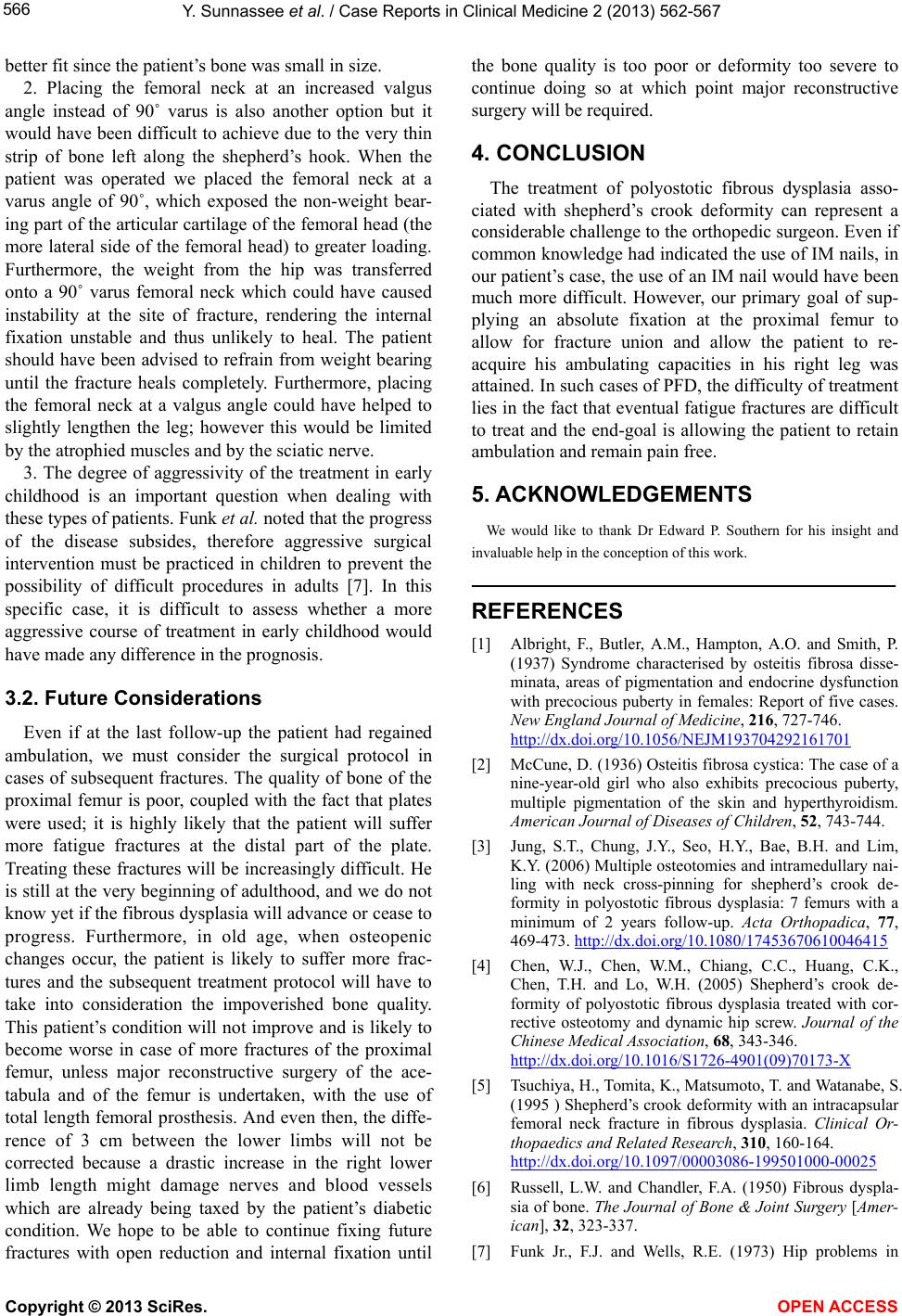
Y. Sunnasse e et al. / Case Reports in Clinical Medicine 2 (2013) 562-567
566
better fit since the patient’s bone was small in size.
2. Placing the femoral neck at an increased valgus
angle instead of 90˚ varus is also another option but it
would have been difficult to achieve due to the very thin
strip of bone left along the shepherd’s hook. When the
patient was operated we placed the femoral neck at a
varus angle of 90˚, which exposed the non-weight bear-
ing part of the articular cartilage of the femoral head (the
more lateral side of the femoral head) to greater loading.
Furthermore, the weight from the hip was transferred
onto a 90˚ varus femoral neck which could have caused
instability at the site of fracture, rendering the internal
fixation unstable and thus unlikely to heal. The patient
should have been advised to refrain from weight bearing
until the fracture heals completely. Furthermore, placing
the femoral neck at a valgus angle could have helped to
slightly lengthen the leg; however this would be limited
by the atrophied muscles and by the sciatic nerve.
3. The degree of aggressivity of the treatment in early
childhood is an important question when dealing with
these types of patients. Funk et al. noted that the progr ess
of the disease subsides, therefore aggressive surgical
intervention must be practiced in children to prevent the
possibility of difficult procedures in adults [7]. In this
specific case, it is difficult to assess whether a more
aggressive course of treatment in early childhood would
have made any difference in the prognosis.
3.2. Future Considerations
Even if at the last follow-up the patient had regained
ambulation, we must consider the surgical protocol in
cases of subsequent fractures. The quality of bone of the
proximal femur is poor, coupled with the fact that plates
were used; it is highly likely that the patient will suffer
more fatigue fractures at the distal part of the plate.
Treating these fractures will be increasingly difficult. He
is still at the very beg inning of adulthood, and we do not
know yet if the fibrous dysplasia will advance or cease to
progress. Furthermore, in old age, when osteopenic
changes occur, the patient is likely to suffer more frac-
tures and the subsequent treatment protocol will have to
take into consideration the impoverished bone quality.
This patient’s condition will not improve and is likely to
become worse in case of more fractures of the proximal
femur, unless major reconstructive surgery of the ace-
tabula and of the femur is undertaken, with the use of
total length femoral pro sthesis. And even then, the diffe-
rence of 3 cm between the lower limbs will not be
corrected because a drastic increase in the right lower
limb length might damage nerves and blood vessels
which are already being taxed by the patient’s diabetic
condition. We hope to be able to continue fixing future
fractures with open reduction and internal fixation until
the bone quality is too poor or deformity too severe to
continue doing so at which point major reconstructive
surgery will be required.
4. CONCLUSION
The treatment of polyostotic fibrous dysplasia asso-
ciated with shepherd’s crook deformity can represent a
considerable challen g e to th e o r thoped ic su rgeon. Ev en if
common knowledge had indicated the use of IM nails, in
our patient’s case, the use of an IM nail would have been
much more difficult. However, our primary goal of sup-
plying an absolute fixation at the proximal femur to
allow for fracture union and allow the patient to re-
acquire his ambulating capacities in his right leg was
attained. In su ch cases of PFD, the d ifficulty of treatment
lies in the fact that eventual fatigue fractures are d ifficult
to treat and the end-goal is allowing the patient to retain
ambulation and remain pain free.
5. ACKNOWLEDGEMENTS
We would like to thank Dr Edward P. Southern for his insight and
invaluable help in the conception of this work.
REFERENCES
[1] Albright, F., Butler, A.M., Hampton, A.O. and Smith, P.
(1937) Syndrome characterised by osteitis fibrosa disse-
minata, areas of pigmentation and endocrine dysfunction
with precocious puberty in females: Report of five cases.
New England Journal of Medicine, 216, 727-746.
http://dx.doi.org/10.1056/NEJM193704292161701
[2] McCune, D. (1936) Osteitis fibrosa cystica: The case of a
nine-year-old girl who also exhibits precocious puberty,
multiple pigmentation of the skin and hyperthyroidism.
American Journal of Diseases of Children, 52, 743-744.
[3] Jung, S.T., Chung, J.Y., Seo, H.Y., Bae, B.H. and Lim,
K.Y. (2006) Multiple osteotomies and intramedullary nai-
ling with neck cross-pinning for shepherd’s crook de-
formity in polyostotic fibrous dysplasia: 7 femurs with a
minimum of 2 years follow-up. Acta Orthopadica, 77,
469-473. http://dx.doi.org/10.1080/17453670610046415
[4] Chen, W.J., Chen, W.M., Chiang, C.C., Huang, C.K.,
Chen, T.H. and Lo, W.H. (2005) Shepherd’s crook de-
formity of polyostotic fibrous dysplasia treated with cor-
rective osteotomy and dynamic hip screw. Journal of the
Chinese Medical Association, 68, 343-346.
http://dx.doi.org/10.1016/S1726-4901(09)70173-X
[5] Tsuchiya, H., Tomita, K., Mat sumoto, T. and Watanabe, S.
(1995 ) Shepherd’s crook deformity with an intracapsular
femoral neck fracture in fibrous dysplasia. Clinical Or-
thopaedics and Related Research, 310, 160-164.
http://dx.doi.org/10.1097/00003086-199501000-00025
[6] Russell, L.W. and Chandler, F.A. (1950) Fibrous dyspla-
sia of bone. The Journal of Bone & Joint Surgery [Amer-
ican], 32, 323-337.
[7] Funk Jr., F.J. and Wells, R.E. (1973) Hip problems in
Copyright © 2013 SciRes. OPEN ACCESS